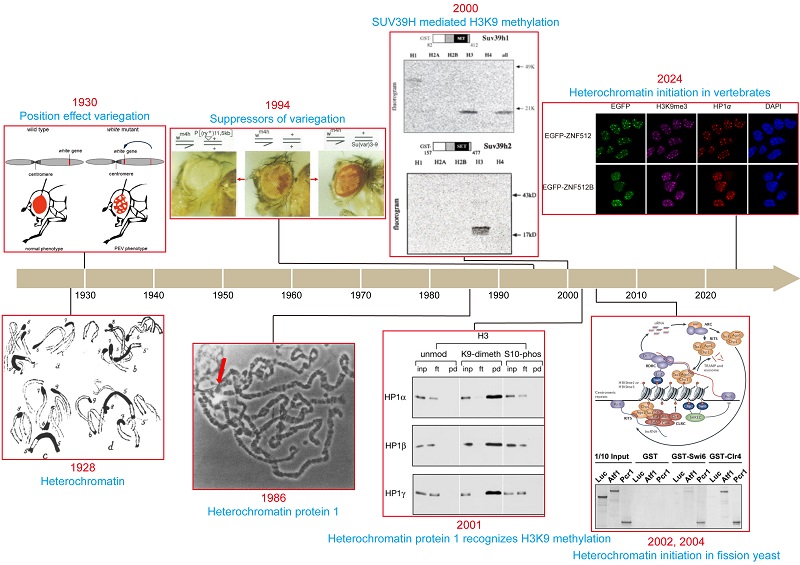ZHU Bing group uncovers the conserved mechanism of pericentric heterochromatin initiation in vertebrates
A study published on Nature on July 4th, 2024, titled Targeting pericentric non-consecutive motifs for heterochromatin initiation, led by Prof. ZHU Bing from the Institute of Biophysics of the Chinese Academy of Sciences, has shed light on the conserved mechanism responsible for the initiation of pericentric heterochromatin in vertebrates.
The concept of heterochromatin was first introduced in 1928, and its functional connection to the first classic epigenetic phenomenon known as position-effect variegation was established in 1930. Despite its widespread presence in eukaryotic species, identifying the critical molecular features of pericentric heterochromatin has been a long journey. A significant milestone in this field is the discovery of SUV39H homologs as H3K9-specific histone methyltransferases in 2000. Subsequent findings in 2001 confirmed H3K9 methylation as the binding platform for HP1 proteins.
Although there is little sequence homology among pericentric regions across eukaryotes, H3K9 methylation remains the principal mark of pericentric heterochromatin, from fission yeast to mammals. Extensive genetic studies in fission yeast, Schizosaccharomyces pombe, have demonstrated that the RNA interference machinery recruits Clr4 (a homolog of SUV39H in fission yeast) to pericentric repeats. Additionally, the site-specific DNA binding proteins Atf1 and Pcr1 recruit Clr4 to the mating type switch locus.
In vertebrates, however, the de novo initiation mechanisms of pericentric heterochromatin formation have been less clear. "We suspected that proteins responsible for the de novo initiation of pericentric heterochromatin might have been overlooked in previous genetic studies due to functional redundancy," said MA Runze, the co-first author of this study.
To identify these candidates, the team employed the highly specific targeting ability of the CRISPR/Cas9 system along with the spatially precise APEX2-based proximity labeling system. This approach allowed them to characterize the protein composition of pericentric heterochromatin in mouse embryonic stem cells. They discovered that the zinc finger proteins ZNF512 and ZNF512B specifically localize to pericentric regions via direct DNA binding. Remarkably, both proteins can initiate heterochromatin formation at ectopically targeted repetitive regions and pericentric regions by directly recruiting SUV39H1 and SUV39H2 to catalyze the formation of H3K9me3 at targeting sites.
Why are seemingly variable pericentric sequences targeted by the same set of H3K9me3-mediated heterochromatin in vertebrates? The authors found that ZNF512 and ZNF512B from different species could target the pericentric regions of other vertebrates specifically. This ability is attributed to the atypical long linker residues between the zinc fingers of ZNF512 and ZNF512B, providing the flexibility to recognize non-consecutive DNA sequences.
Even though SUV39H1 and SUV39H2 are thought to have redundant activities, the authors discovered distinct properties between these enzymes. SUV39H2 displays a higher preference for H3 tails and appears to be a more efficient enzyme, while SUV39H1 likely has a stronger silencing effect due to its higher affinity for HP1 proteins.
"We have addressed two long-standing questions: how constitutive heterochromatin is initiated and how seemingly variable pericentric sequences are targeted by the same set of conserved machinery in vertebrates.", remarked Prof. ZHU Bing, the corresponding author of this study. "The recognition of non-consecutive DNA sequences by the split zinc fingers is profoundly significant, revealing a new pattern of DNA recognition. This discovery might lead to identifying more such examples and assist bioinformaticians in developing new algorithms to identify DNA binding motifs in the future."
This work was funded by grants from the China Natural Science Foundation, the National Key R&D Program of China, the Chinese Academy of Sciences, the New Cornerstone Science Laboratory, and the Youth Innovation Promotion Association of the Chinese Academy of Sciences.

Figure 1. History of constitutive heterochromatin.
(Image by ZHU Bing's group)
Key principles of constitutive heterochromatin from fission yeast to mammals, spanning from its initial discovery in 1928 to 2024. Image created by Runze Ma, with copyright held by Runze Ma. Modified panels of this image are cited from PMID: 377956, PMID: 26733936, PMID: 3099166, PMID:7915232, PMID: 10949293, PMID: 11094092, PMID: 11242053, PMID: 25554358, PMID: 15218150, and this work.
Article link: https://www.nature.com/articles/s41586-024-07640-5
Contact: ZHU Bing
Institute of Biophysics, Chinese Academy of Sciences
Tel: 010-64888832
E-mail: zhubing@ibp.ac.cn
(Reported by Prof. ZHU Bing's group)

